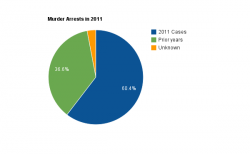Over the past two weeks, Homicide Watch DC has brought you a special series of stories about 2011 homicides in the District. We’ve published a Q&A with US Attorney Ronald Machen, guest columns from Mayor Vincent Gray and councilmembers, and in-depth looks at cold case investigations, how the judicial process works, and more.
But Homicide Watch certainly wasn’t alone in taking a look at 2011. Here’s how our colleagues at other media outlets covered the stories.
Read more
Every murder case begins, publicly, when a suspect is presented with a charge.
At DC Superior Court, this happens in Courtroom C-10, a large room on the lowest floor of the courthouse. A gallery of benches face the judge, who sits at the top of a three-tiered dais.
Suspects are brought in from the judge’s left. Some wear bright orange jail jumpsuits, others are still dressed in the clothes they were arrested in. All are shackled at their hands and feet.
Nearly every suspect scans the audience for family and friends as they are brought before the judge.
Read more
Trials for more than two dozen murder cases are already scheduled on the 2012 judicial calendar. Dates as far out as Nov. 19 have been penciled into judge’s schedules.
Of murders that have occurred since Oct. 2010, 25 cases are currently scheduled for 2012 trials.
Read more
An additional judge will be assigned to murder cases on a regular basis at D.C. Superior Court in 2012, bringing the total number of judges regularly assigned to murder cases to five.
The decision to add a judge to the Felony 1 calendar of the District’s most serious cases was made by Chief Judge Lee Satterfield. Satterfield also reassigned certain calendars, meaning that cases that were being heard by one judge in 2011 may be heard by another judge in 2012.
Read more

Time to first arrest. Click to view larger.
Murder cases are being closed faster than ever, DC Police Chief Cathy Lanier said Friday. “The time it takes us to close a case has dropped dramatically.”
She credits cooperation between law enforcement, prosecutors and the community with quick arrests, many happening at or near the crime scene.Read more
“We used to be known as the murder capital of the world and the city of unsolved homicides,” DC Police Chief Cathy Lanier said at a press conference marking the end of a year that has seen the District’s murder rate drop to its lowest level since the early 1960s.
“Our detectives and our police officers have done an amazing job in turning that around,” Lanier added. “We are no longer either one of those things.”
Mayor Vincent Gray joined Lanier at MPD headquarters today for a far-reaching roundup of the year in crime.
Read more
 At a press conference today at MPD headquarters, Police Chief Cathy Lanier and DC Mayor Vincent Gray both touted the city’s 94 percent homicide case closure rate for the year.
At a press conference today at MPD headquarters, Police Chief Cathy Lanier and DC Mayor Vincent Gray both touted the city’s 94 percent homicide case closure rate for the year.
Gray called the number “astounding.”
Said Lanier, “We used to be known as the murder capital of the world and the city of unsolved homicides. Our detectives and our police officers have done an amazing job in turning that around. We are no longer either one of those things.”
But understanding where this number comes from is important: 37 of the homicides counted toward the year’s closure rate were not committed in 2011.
Read more
 Beginning in July and continuing through the fall, transgender activists sounded an alarming message: the District was becoming a dangerous place for members of their community.
Beginning in July and continuing through the fall, transgender activists sounded an alarming message: the District was becoming a dangerous place for members of their community.
Early in the morning of July 20, 23-year-old LaShay McLean was fatally shot on the 6100 block of Dix Street. Less than two months later, on Sept. 10, Gaurav Gopalan was beaten to death just a few blocks from his home in Columbia Heights. At the time he was killed, Gopalan, 35, was dressed as a woman. It was a side of himself that friends said he was just beginning to embrace and explore.
Read more
Tanya Brice was on the phone with her mother one evening when she realized that her boyfriend, James Lott, had been gone a long time taking out the trash. She was saying as much to her mother when she heard shots.
“I thought they were firecrackers because it was close to Fourth of July,” she said.

James Lott- as pictured on an MPD reward poster
But when she looked outside she saw Lott lying next to the trash, blood was coming from his mouth and underneath his stomach.
That was the evening of June 24, 2007 and when detectives arrived at the house they began investigating Lott’s death immediately. The cause of death: gunshot wounds. The manner of death: homicide.
In the four and half years that have passed since that night, Brice has found little peace. The question she and the rest of Lott’s family are left with, who killed their son, their brother, their boyfriend, remains unanswered.
It’s one of hundreds of unsolved homicides in the District of Columbia.
Read more
This was just one of countless messages about violence in DC that were posted to Facebook, Twitter and YouTube this year.
Many of the messages were heartbreaking. Some were funny. All were real. And all spoke to the reality of living— and dying— in this city.
Read more










